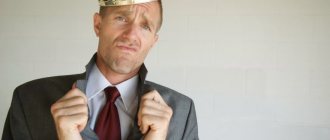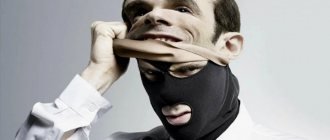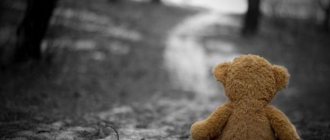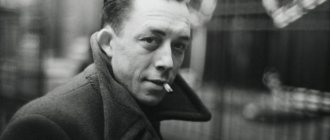Classification of people by temperament
Few people know that the founder of the definition of personality types is the famous ancient Greek physician and philosopher Hippocrates. Being a leading doctor of his time, he conducted many interesting experiments.
Since Hippocrates was a supporter of materialism, he tried to find a connection between temperament and the amount of one of 4 fluids in the body: lymph, blood, yellow and black bile.
As a result, he introduced 4 main types of temperament:
- choleric;
- phlegmatic person;
- melancholic;
- sanguine
According to Hippocrates, yellow bile predominated in the body of choleric people, black bile - of melancholic people, lymph - of phlegmatic people, and blood - of sanguine people.
For obvious reasons, modern medicine cannot take seriously these conclusions of the famous ancient Greek doctor, who did not leave behind any explanation as to how he managed to identify such patterns.
An interesting fact is that Hippocrates compared a person’s character with his physical health. He believed that in our body thoughts, the state of organs and emotions are inextricably linked.
In modern medicine and psychology there is such a direction as psychosomatics. Psychosomatics (“psyche” - soul and “soma” - body) studies the influence of psychological factors on the occurrence and course of somatic (bodily) diseases. By approaching this issue correctly, many people have managed to get rid of various ailments associated with psychosomatics.
Homo sapiens species
According to the most common hypothesis, humans and some species of modern monkeys have the same ancestor. There is a number of evidence for this. The Hominid family is characterized by an important feature - upright walking. This trait was certainly associated with a change in lifestyle, which led to the release of the forelimbs and the development of the hand as an organ of labor.
The process of becoming a modern species took place in several stages: the most ancient, ancient and first modern people. These phases did not replace each other, but coexisted and competed with each other for a certain period.
The most ancient, or ape-people, knew how to independently make tools from stones, make fire, and lived in a primary herd. The ancients, or Neanderthals, communicated using gestures and rudimentary articulate speech. Their tools were also made of bone. Modern people, or Cro-Magnons, built their own homes or lived in caves. They sewed clothes from skins, knew pottery, tamed animals, and grew plants.
Man, whose taxonomy is determined by the totality of anatomy, physiology and behavioral reactions, is the result of long-term evolutionary processes.
Temperament types
Let's briefly look at each type of temperament and give it the corresponding characteristics.
Melancholic people
Of the 4 personality types, melancholic people are the “weakest”. They have weakly expressed inhibitory and excitatory processes, which makes them very sensitive.
Even something insignificant can cause melancholic people to worry. They are often depressed and more prone to depression. Among them you can often find neurasthenics who carefully hide their emotions.
For this reason, melancholic people may develop mental and nervous disorders, which in turn can cause diseases of the stomach, cardiovascular system, and liver.
Cholerics
Cholerics by nature are the complete opposite of melancholics. They are distinguished by an unbalanced and firm character.
An interesting fact is that people with this personality type are more likely than others to suffer from liver and gall bladder diseases. It is difficult for them to control their emotions, as a result of which they are characterized by irritability, outbursts of anger and often rage.
As a rule, choleric people have difficulty getting along with people. They are very impulsive, fussy and lively in conversations with their interlocutor.
Sanguines
Sanguine people are the most “lively” personality type. They are strong, balanced, active and often take the initiative. As a rule, sanguine people are inclined to work, as a result of which they are afraid of not being able to do something or making a mistake.
They are demanding not only of themselves, but also of others, which sometimes leads them to stress or depression.
People with this personality type most often suffer from diseases of the cardiovascular system. They are also susceptible to strokes and heart attacks.
Phlegmatic people
Phlegmatic people belong to the “calm” personality type. They are distinguished by prudence and balance. It is very difficult to piss them off.
This type of personality is not difficult to identify in a crowd of people: in the process of any unrest or general panic, they remain calm and try to stay away from the events taking place.
Phlegmatic people prefer not to get upset over trifles, trying not to take everything to heart. Despite this, they are the ones who suffer from stomach ulcers more often than other types.
Read more about temperament types here.
Man's place in the animal world
Not everyone knows which kingdom a person belongs to. According to modern scientific classification, people belong to the Animal kingdom. Belonging to this kingdom has been proven by numerous studies of the first representatives of the genus.
What class does it belong to?
Humans belong to the phylum Chordata, class Mammals, order Primates, family Hominidae and genus Humans. It is the only representative of the species. The expanded classification indicates membership in the subtype Vertebrates.
Features of the external and internal structure, lifestyle, and nuances of reproduction are studied in a school biology course. There are other sciences that study human beings: psychology, sociology, cultural studies, genealogy.
Social personality types
In sociology, personality types are related to historical, economic, social and cultural events that directly influence them.
Here, as in psychology, you can find a variety of personality types. According to Max Werber, people must be divided according to their degree of rationality.
Taking this factor into account, there are two personality types:
- rationalists;
- irrationalists.
In turn, Erich Fromm suggests dividing people into 3 types:
- receptive (passive) – ready to obey others;
- exploitative - those who take advantage of other people's labor;
- accumulators – prone to market relations.
Sociology divides people into the following types of personalities:
- traditionalists;
- realists;
- idealists;
- hedonists;
- frustrated type.
Traditionalists tend to be orderly and disciplined. They try to live by the law and do not strive for self-improvement.
In contrast to them, realists, on the contrary, try to realize themselves in life. In addition, they try to keep their emotions under control and not fall into hysterics.
Idealists include those who strive for independence and fight against established rules.
Hedonists are not at all interested in what is happening in society. Most of all, they want to receive satisfaction from life, which manifests itself in material values and sensual pleasures.
A frustrated personality type is characterized by low self-esteem. They feel superfluous in society, as a result of which such people often become outcasts or homeless.
Anthropogenesis and its driving factors
Anthropogenesis is the historical process of the emergence and evolution of man, his formation as a species as a result of the interaction of biological and social factors.
The driving factors of anthropogenesis are divided into biological (characteristic of all living nature) and social (characteristic only of humans).
The role of biological factors:
■ ensuring morphophysiological changes (upright posture, developed hand, large brain) in the process of individual selection;
■ freeing the forelimbs from the function of movement and their adaptation for attack and defense at a distance with the help of various objects, the manufacture of primitive tools, and simple labor activities;
■ improvement of forms of relations in the primitive human herd in the process of group selection, which operated at two levels: family (selection of small groups) and tribal (selection of large settlements or tribes).
❖ The role of social factors (it was revealed by F. Engels in his work “The Role of Labor in the Process of Transformation of Ape into Man”):
■ man himself and human society were created by labor activity , social labor. The distant ancestors of man first used natural tools of hunting and labor, and with the freeing of the hand from movement, they began to make artificial tools, while even the most primitive tools of hunting and labor reduced man’s dependence on the surrounding nature;
■ the manufacture and improvement of hunting and labor tools led to the development of small muscles of the hand and caused a corresponding development of the entire body and motor areas of the cerebral hemispheres;
■ group cooperation provided more reliable defense in open landscapes where human ancestors lived;
■ joint hunting of large mammals made it possible to create food reserves for future use and freed up time for making more advanced hunting and labor tools, raising children, caring for the elderly, etc.;
■ herd lifestyle, collective hunting and gathering required coordinated actions and communication. The gradual transformation of the larynx and oral apparatus led to the development of articulate speech , which made it possible to exchange information between individuals, different groups and generations and thereby use the knowledge and individual experience of all members of the group and previous generations (social inheritance). Along with speech, a person acquired the ability to think;
■ the presence of permanent dwellings made it possible to: - maintain a fire and use it for heating and cooking. The use of fire for heating made it possible for people to settle in areas with colder climates, and the consumption of thermally processed animal food led to changes in the chewing apparatus, a reduction in the facial skull, better absorption of food, a sufficient supply of essential amino acids to the body, and an enlargement of the brain;
— lengthen the time spent caring for children and their education . This led to group mating with increased male involvement in caring for females and children. Females with children obtained plant food by gathering, and males provided protein-rich food of animal origin to females and children. If the female managed to keep the male near her, then both she and her children survived (this is how monogamous marriage arose) -,
- take care of sick members of the group and the elderly - carriers of valuable individual experience in making tools, methods of hunting, etc.
■ the domestication of animals and the cultivation of crops made it possible to avoid starvation and increase the variety of food.
❖ Changing role of driving factors of anthropogenesis
■ Biological factors played a major role in the initial stages of human development (ancient and ancient people). The scope of their action gradually narrowed as a result of human labor activity and the creation of artificial living conditions (clothing, housing, fire, etc.). At present, the intraspecific struggle for existence, natural selection and isolation in human populations, due to the social nature of man, have lost their species-forming function and perform only a stabilizing function; population waves can only affect sparsely populated regions; the mutation process and genetic drift remain important.
■ A high degree of brain development and collective work have significantly weakened the effect of biological and strengthened the role of social factors in anthropogenesis . Man began not only to adapt to his environment, but also gradually learned to change it in the direction he needed. The further progress of humanity will depend on social factors.
Personality types in socionics
In the 1970s, based on Jung's typology and Kempinski's theory of information metabolism, socionics arose - a new concept of personality types and the relationships between them.
In socionics, personality types are considered depending on how the following characteristics are combined in an individual:
- introversion and extroversion;
- logic and ethics;
- rationality and irrationality;
- sensory and intuition.
Let's briefly consider socionic personality types.
INTROVERTS – the driving force is self-interest. These are closed individuals with communication problems, completely focused on their inner world. Characterized by an inward orientation of life.
EXTROVERTS – the driving force is external factors. Extroverts are open and ready to communicate people who are not always capable of independence. Characterized by an outward direction of life. Read more about extroverts and introverts here.
LOGICIANS rely on logical thinking, which helps them arrive at the truth.
ETHICISTS adhere to traditional moral norms and concepts. People with this personality type are keenly interested in art and creativity.
RATIONALISTS put reason in the first place with principles and traditions established in society.
IRRATIONALISTS try to improve themselves and constantly strive for innovation. They are characterized by unconventional thinking and creativity.
SENSORS try to process information not in time, but in space. They consider it important to experience sensations. They are interested in art and the beauty of nature. Sensors pay attention to events occurring at the present time, but they care little about the future.
INTUITS prefer to get acquainted with different information in accordance with time, and only then watch how events will develop. People of this type are absent-minded and do not strive for improvement.
Life cycle
The biological species leads a special way of life, different from other representatives of the class Mammals.
Breath
The organs of the respiratory system play an important role in gas exchange. The process begins in the nasal cavity, the air masses warm up, enter the trachea and bronchi, and then into the lungs. From there, oxygen molecules are transported through the bloodstream to all organs and tissues.
The reverse flow of blood carries carbon dioxide molecules that are expelled. Red blood cells, or erythrocytes, carry oxygen in the body. With their deficiency, oxygen starvation of organs occurs.
Nutrition
Representatives of the genus Humans are omnivorous mammals. They eat plant and animal foods. The second one must be thermally treated before use.
Teeth and tongue are important parts of the digestion process. The first helps to grind the products, the second helps to push them into the esophagus. After entering the stomach, active production of hydrochloric acid begins, bile comes from the gallbladder, and the pancreas produces enzymes for digesting food. Afterwards, food enters the small intestine, then into the large intestine.
After final processing and absorption of nutrients, the products are excreted in the feces. The normal functioning of the digestive system largely depends on the composition of the diet and the predominance of certain products in it. People eat many mammals, mollusks, and birds.
Reproduction
Individuals from the family Hominidae are dioecious and are characterized by viviparity. Puberty occurs at the age of 15-18 years. The ability to conceive depends on a woman's menstrual cycle, which lasts on average 28 days. During pregnancy, a woman is sexually active, which is not typical for other mammals.
Reproductive function in women lasts up to 40-50 years, after which menopause occurs. Men are usually able to conceive even in old age.
Fertilization is internal, the growth of the fetus occurs in the woman's uterus. After 40 weeks of intrauterine development, a fully formed baby is born. For several months, he feeds on mother's milk, which ensures the supply of necessary substances and strong immunity. The birth of more than 1 baby occurs approximately once in 80-90 births.
No baby mammal requires as much attention and care as a human baby. Both parents usually take part in raising the child.
Lifespan
The average life expectancy of individuals in developed countries exceeds 70 years. In others, this figure is 65-69 years.
In most cases, the indicator depends on dietary habits, professional activities and hereditary predisposition.
Similarities and differences with animals
Speaking briefly about man's place in the system of the organic world, one should distinguish between his biological and social roles. A person has natural needs (sleep, food, mating), but at the same time is able to control his desires, learn, and engage in creativity.
Despite the fact that humanity is an animal species, in the course of development, man has acquired unique anatomical and social qualities. The table shows the similarities and differences between humans and other mammals.
TOP 4 articles that are read along with this
- 1. Biology (8th grade): Speech
- 2. Human anthropogenesis
- 3. Social factors of anthropogenesis
- 4. Type Chordata
| Similarities | Difference |
|
|
Rice. 2. The brain of humans and other mammals.
Atavisms - spontaneously appearing signs inherent in ancestors, and rudiments - organs that have lost their significance indicate that a person belongs to the animal kingdom. Atavisms include abundant hair throughout the body, including the face, tail, multiple nipples, and pronounced fangs. The rudiments include the appendix, the third eyelid, and the muscles of the auricles.
Rice. 3. Hypertrichosis – excessive hair growth.










